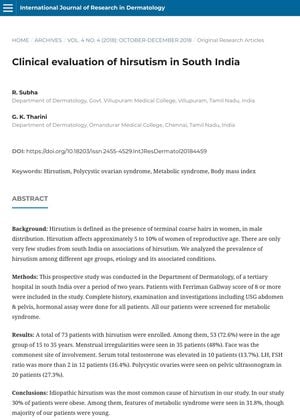Clinical Evaluation of Hirsutism in South India
October 2018
in “
International Journal of Research in Dermatology
”

TLDR Most women with excessive hair growth in South India have hirsutism without a known cause, with common facial hair growth and some showing hormonal imbalances and polycystic ovaries.
The study "Clinical evaluation of hirsutism in South India" conducted by R. Subha and G. K. Tharini over a period of two years involved 73 patients with hirsutism, a condition characterized by excessive hair growth in women. The majority of the patients (72.6%) were aged between 15 to 35 years. The most common site of excessive hair growth was the face. The study found that idiopathic hirsutism, a form of the condition with no identifiable cause, was the most common type among the participants. Elevated levels of serum total testosterone were found in 13.7% of the patients, while a LH, FSH ratio of more than 2 was found in 16.4% of the patients. Polycystic ovaries were identified in 27.3% of the patients through pelvic ultrasonograms. The study also found that 30% of the patients were obese, and among them, 31.8% showed features of metabolic syndrome.
